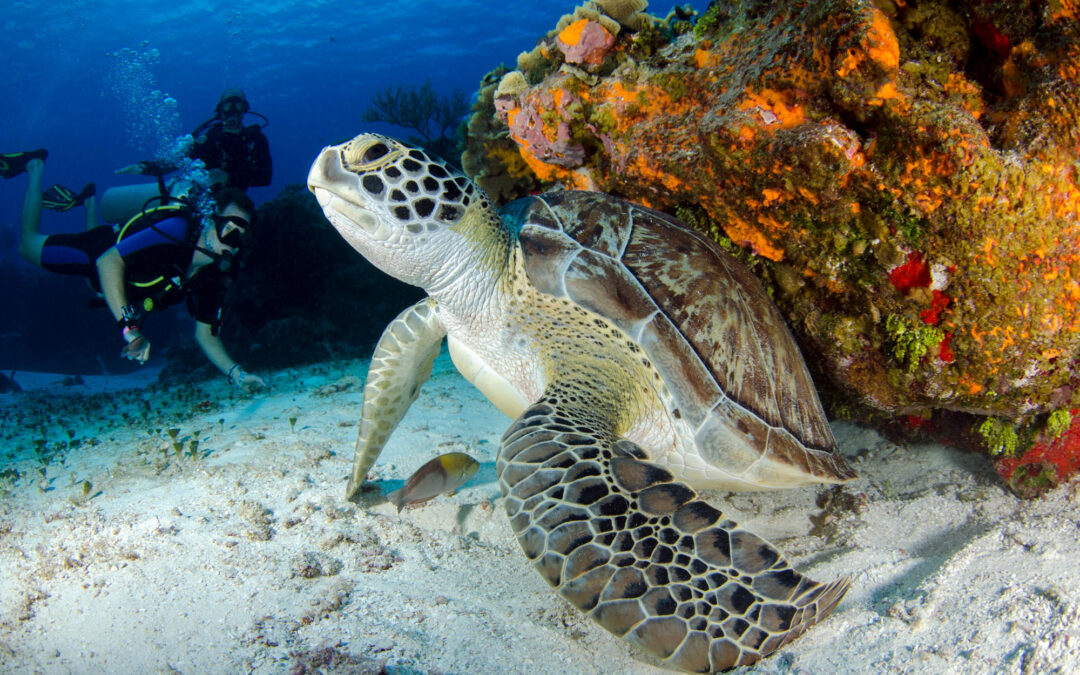Diving in the Galapagos Islands is like entering an underwater world unlike any other on Earth. The islands’ unique geography and isolated location create an ideal environment for an incredible diversity of marine species, many of which are found nowhere else. From hammerhead sharks and playful sea lions to graceful rays and colorful reef fish, the Galapagos offers divers a rare opportunity to encounter an array of fascinating creatures. Here’s a guide to the remarkable marine life you can expect to see while diving in the Galapagos Islands.
1. Hammerhead Sharks
One of the most iconic species in Galapagos waters, the scalloped hammerhead shark is often seen in large schools, particularly at Darwin and Wolf Islands. These unique sharks, with their distinctive head shape and shy yet curious behavior, are a highlight for divers. Peak season for seeing hammerheads is June to November, when the colder Humboldt Current brings nutrient-rich waters, attracting these impressive animals in large numbers.
2. Galapagos Sharks
Named after the islands, Galapagos sharks are commonly found in these waters, especially around Wolf and Darwin Islands. These sharks are inquisitive but generally non-aggressive, and their presence adds to the excitement of diving in the area. They’re often seen cruising along steep walls and rocky reefs, and can be spotted year-round.
3. Sea Lions
Known for their playful and curious nature, Galapagos sea lions are one of the most beloved inhabitants of the islands. Divers often encounter these agile swimmers up close, as they dart through the water in groups or approach divers with playful interest. Particularly common around North Seymour and Floreana Islands, sea lions are active year-round, adding a fun, interactive element to any dive.
4. Manta Rays and Eagle Rays
Manta rays and eagle rays are a common sight in the Galapagos, particularly around Isabela Island and Cape Marshall. Manta rays, with wingspans that can exceed 20 feet, are especially majestic as they glide through the water. Divers may also encounter groups of spotted eagle rays moving gracefully in formation, a mesmerizing experience that’s typical of the Galapagos dive environment.
5. Whale Sharks
The largest fish in the ocean, whale sharks are a seasonal highlight for divers in the Galapagos. These gentle giants are frequently spotted near Darwin and Wolf Islands from June to November, when the colder currents bring nutrient-dense waters. Seeing a whale shark, with its enormous size and slow, graceful movements, is a once-in-a-lifetime experience for many divers.
6. Marine Iguanas
Found only in the Galapagos, marine iguanas are the world’s only sea-diving lizards. While more commonly seen basking on the rocks, some lucky divers may spot these reptiles swimming along the rocky shores, feeding on algae. Punta Espinosa on Fernandina Island is one of the best places to see marine iguanas in action, offering a unique and surreal experience.
7. Galapagos Penguins
The northernmost penguin species, Galapagos penguins are an endearing sight for divers and snorkelers alike. Found primarily around Bartolome Island and Isabela Island, these small penguins are known for their quick, agile swimming and charming behavior. Though often spotted on the shore, they can sometimes be seen diving and hunting for fish underwater, providing a delightful encounter for divers.
8. Sea Turtles
The warm waters around the Galapagos are home to several species of sea turtles, with green sea turtles being the most common. These gentle creatures are frequently seen at sites like Cousins Rock and Punta Vicente Roca, where they feed on seagrass and algae. Watching a sea turtle glide through the water is always a serene experience, and the Galapagos offers countless opportunities to observe these ancient mariners up close.
9. Colorful Reef Fish
The coral reefs in the Galapagos host an impressive diversity of colorful reef fish, many of which are endemic to the islands. Divers will encounter a kaleidoscope of species, including parrotfish, king angelfish, and the vibrant blue-and-gold yellowtail surgeonfish. These fish add a burst of color to the reefs, and their presence reflects the health and diversity of the Galapagos marine ecosystem.
10. Spotted Moray Eels
Frequently seen poking their heads out from crevices in the reef, spotted moray eels are common throughout the Galapagos. With their long, slender bodies and distinct patterns, these eels are both fascinating and slightly mysterious. Divers can find them at various sites around the islands, often sharing their hiding spots with smaller reef fish.
Conservation and Responsible Diving in the Galapagos
The Galapagos Islands are a protected area, with strict regulations in place to preserve their unique ecosystems. When diving in the Galapagos, it’s essential to practice responsible diving habits to minimize impact on the environment. Divers are encouraged to maintain a safe distance from marine life, avoid touching corals, and choose eco-friendly dive operators who prioritize conservation.
The Galapagos Marine Reserve is one of the world’s most biodiverse marine areas, and responsible diving helps ensure that these underwater treasures remain intact for future generations. By respecting the environment and the creatures that inhabit it, divers can contribute to the preservation of this extraordinary ecosystem.
Final Thoughts
Diving in the Galapagos offers encounters with some of the most remarkable marine species in the world. From schools of hammerhead sharks to playful sea lions and the gentle glide of a manta ray, the Galapagos Islands provide experiences that few other destinations can match. Each dive is an opportunity to witness the magic of nature in one of the world’s most ecologically significant regions.
Whether you’re a seasoned diver or embarking on your first dive trip, the Galapagos promises a journey into an underwater paradise filled with life and wonder. With this guide to the marine life you can expect to see, you’re one step closer to diving into the rich, vibrant waters of the Galapagos Islands.

